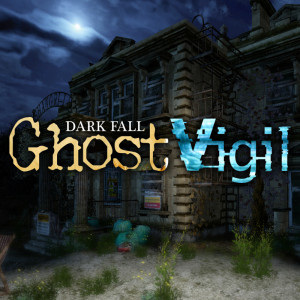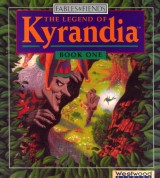Review for Dark Fall: Ghost Vigil

Floorboards creek. A penny drops in the distance. Eerie whispers of maybe-ghosts, maybe-wind blow through dusty, darkened corridors. A two hundred-year-old mansion turned orphanage turned long abandoned school looms forebodingly in the night sky. This is Harwood House, the location that you and a team of paranormal investigators will be searching in the hopes of proving life after death does exist in Darkling Room’s first-person point-and-click horror adventure Ghost Vigil, the fourth installment in the Dark Fall series. While the hunt itself can be boring at times, the puzzles found within the house’s walls are consistently intriguing. And if those aren’t enough to keep you awake, the tense, creepy atmosphere that shrouds everything like a dark cloak likely will.
You are the newest nameless, faceless recruit of the Oxford Paranormal Group. It’s a bit more impressive and official-sounding than it actually is, as the O.P.G. is really just three college kids operating out of a van. Steve is a physics student and group founder. He’s also something of a nag and rather condescending. Jen is studying English history and literature and is the team’s researcher. Bear is a computer science student and is therefore the resident techie. The four of you have traveled to the boarded-up Harwood House where a series of grisly deaths have occurred over the many years of its history – deaths that have hopefully left provable supernatural traces behind; maybe even a ghost or two.
For your investigation, you are equipped with many tools that real-world ghost hunters use. This includes the E.M.F. (Electromagnetic Field Meter) for detecting energy sources; the “Ghostbox” scanner, which searches radio frequencies for ghostly transmissions; a voice recorder for capturing E.V.P.s (electronic voice phenomena) from wailing wayward spirits; a night vision video camera, which can reveal messages and symbols invisible to the naked eye; a thermal scanner for identifying abnormally hot or cold spots; a walkie-talkie for keeping in contact with the others; and a computer tablet for recording and analyzing the evidence you collect.
It’s an impressive array of technology and I was initially very excited by the possibilities as it lends a great deal of verisimilitude to the experience. The drawback is that with the exception of the night vision camera, you can only have one piece of equipment operational at a time. And since you never know where an E.V.P. or a thermal change might turn up, for example, you have to carefully trawl through every screen (normal views and close-ups) with every piece of equipment on the off-chance that a trigger for that particular device might be there. I found that whenever a new part of the house became available, it typically took me 30-45 minutes just going back and forth through every stopping point to test them all. And each successive time it felt like more and more of a chore.
Fortunately, scanning the environment with ghost hunting gear isn’t the only task Ghost Vigil presents. While experimenting with all the tech takes up a lot of play time, just as much, if not more, is spent actually investigating the mysterious goings-on at the house. Over the years it has been used for a number of different purposes. During your search you’ll learn about the original inhabitants, the Harwood family, as well as a worker who stabbed herself to death with a shard of mirror, a science teacher who committed suicide in front of his class to be with a ghostly spirit, a child who starved because a dark creature kept consuming the food out of his stomach, and a variety of other departed souls. At first glance the deaths seem to be disparate, but they do have a thread running through them, which the previous residents of the building all feared: the Dark Fall.
I’ve never played any of the other Dark Fall games and I was a little concerned that my lack of familiarity would be a hindrance, but in some ways I think it was actually helpful as it was quite engaging learning what the Dark Fall is from scratch. Notes and recordings left by those who came before you hint at a sinister presence with wicked intent. Children’s drawings depict a vaguely humanoid shape shrouded in shadow with glowing eyes. The truth, when ultimately revealed, doesn’t quite live up to the hype, but until that point it makes for an engaging mystery, especially if you play at night. With the lights out. And the sound turned up.
One of the greatest strengths here is definitely the atmosphere. In classic ghost hunting fashion, the O.P.G. decides their investigation is better conducted after sundown than during daylight hours. As a result, the house is very dark and can only be partially lit by the flickering bulb of a flashlight (or rather a torch, since this game takes place in Britain). As you move the mouse pointer across the screen, the flashlight’s circle of illumination travels with it. Everything within its beam can be clearly made out, but you always have the ever-present darkness creeping in around the edges. It’s a nice compromise that makes the setting feel more oppressive and ominous while still allowing players to see everything they need.
Sound is also excellently employed in Ghost Vigil. Creaks, thumps, and rattles abound in the old decrepit manor. As the game progresses and you get closer to the center of the spiritual disturbances, whispery voices and footsteps begin to emanate from the darkness. More substantial voices are also heard periodically, belonging to the three other O.P.G. members speaking to you via walkie-talkie (you never interact with them face to face), as well as those of some of the dearly departed still haunting Harwood. Music is forsaken to remove the comfort it usually brings and to allow the ambient effects to take center stage. It all makes for a richly creepy experience.
In the early sections of the game, your colleagues (well, really just Steve) don’t want you wandering all over the house, so they relegate you to checking out a few minor disturbances in the attic. The start can be a little overwhelming, as all the equipment is dumped on you with minimal explanation on how to use it (even after finishing I still don’t know if the EMF Meter requires actually clicking on electrical sources or just mousing over them to have the game register their detection). Meanwhile, the crew keeps interrupting your early forays with questions about what you’ve found. These queries are answered through a series of buttons displayed at the bottom of the screen, which highlight the importance of keeping a healthy supply of notepaper on hand because when they come up you are no longer allowed to move. (Dang it, Steve, would you quit asking me about the picture frame that’s right next to me for a moment so I can turn and look at it?) Note-taking is a must as you progress further and further and begin to encounter the game’s many puzzles.
As you uncover additional details about Harwood’s various hauntings, the O.P.G. gives you more and more responsibility and makes other parts of the house available to you. Given that the entirety of the game takes place within the mansion and its immediate grounds, this gatekeeping ensures that there’s a steady stream of new sights on offer. From the cramped, dusty attic, to a cluttered science lab, to a greenhouse with still-vibrant foliage, to wood-paneled classrooms, to austere, almost clinical orphanage staff areas, there are a lot of different scenes all crammed into this one locale.
These places aren’t empty by any means, as the previous residents left behind numerous mysteries and puzzles that need solving. The latter range from the simple – find the combination to open a padlock – to the complex. One layered puzzle, for example, involves relating clues from no fewer than three different sources just to open a secured locker. Useful information is scattered all around the house and part of your task is figuring out which pieces go with which obstacles. Some of the connections can be a little tenuous and a bit more direction, especially early on, would have been appreciated at times, but on the whole, with close attention paid and a detailed set of notes taken, the links between puzzle elements are logical.
With its varying degree of difficulty, the puzzle challenge is quite good and enjoyable overall. A few rough spots creep in around the edges, though. In some cases they’re outright bugs, such as the image for the wrong tool from the inventory displaying at times, although this never prevented me from progressing. Elsewhere it’s down to some poor design decisions instead. For instance, on a couple of occasions you have to monitor an array of cameras situated around the house from a laptop. With these you can capture various ghostly phenomena (sounds, glowing orbs, shadowy figures, etc.). You will have to keep finding these until the game arbitrarily decides that you’ve done enough to unlock the next puzzle or section of the house. There’s never any indication of how many such events you have to find and the sequences go on for quite a while. However, these pale in comparison to my single biggest gripe with the gameplay.
At one point you must play a minigame of Snakes and Ladders. Now, Snakes and Ladders is nothing but a dice-roll-and-move game. There are no choices to make, no player input to contribute. It all comes down to pure, simple, random chance. Here I spent nearly an hour “playing” no less than eight times before finally having the outcome resolve in my favour. After the third try, I thought I must be missing something. Surely there was a clever adventure game solution to it. Maybe I had to find a weighted die. Or possibly trick my opponent some way. Perhaps I had to bump the table the game board was on. Nope. I even consulted a walkthrough to be sure. You could get lucky and finish much sooner than I did, but presumably you also could get stuck playing dozens of times. Yikes!
When not trapped playing board games of chance, navigation within Ghost Vigil operates like a typical slideshow-type game with explorable nodes. Clicking directional cursors moves you through a series of static shots, with most locations allowing movement forward and turning left or right. Some places also allow for entering a close-up view to better discern details or read documents. On the whole, getting around the house and its surrounding grounds is quite simple. There are only one or two awkward points, and even with these I never found myself getting disoriented by moving too far from a single click or feeling like things were spaced too far apart.
Despite several dramatically tense moments, there are no jump scares, timed sequences or dead ends resulting in death. Even so, the creepy atmosphere did have me using the save system fairly frequently. Eight manual slots are available and one autosave, although the latter seemed to stop working for me shortly after finishing the opening attic section.
The game features two different endings based on how the final puzzle is solved. I found both endings to be a bit abrupt, leaving a number of questions outstanding. However, given the nature of Harwood’s mysteries, I kind of like the fact that not everything gets wrapped up in a neat bow. There is also a third ending unlocked by solving an optional puzzle based on information from one of the other Dark Fall adventures. Not having played this game’s predecessors, the third ending didn’t make any sense to me (I looked up the answer to the optional puzzle, in case you were wondering how I solved it, and I know you were) but I would guess it's understandable to longtime series fans.
With long stretches of scanning locations with every available tool, a few glitches, and an intolerable random chance minigame segment, Dark Fall: Ghost Vigil can be a bit trying at times. But in between, the stories surrounding the many deaths in Harwood House, the mystery of the Dark Fall, and the multi-layered puzzles requiring copious note-taking really made the game work for me. Add to that the tense but not too terrifying atmosphere and you have one pretty compelling package. Coming in at fourteen hours of play time (even consulting a walkthrough on a couple of occasions), this is a weighty ghost hunting experience. If you have the patience, your investigation will be a rewarding one with just enough spook factor to keep things engaging without sending you hiding under the bedsheets.
Our Verdict:
Although scouring Dark Fall: Ghost Vigil’s haunted Harwood House for supernatural signs can be tedious at times, the puzzles that lurk within its genuinely dark and spooky walls are anything but.



_capsule_fog__medium.png)


























